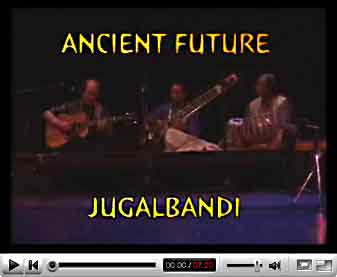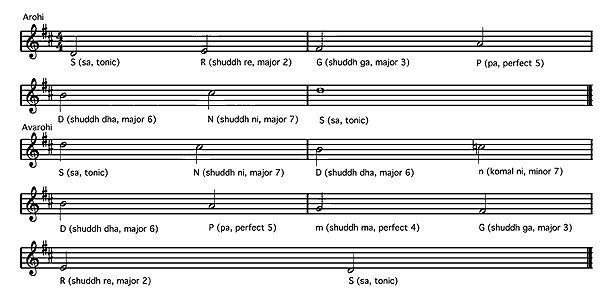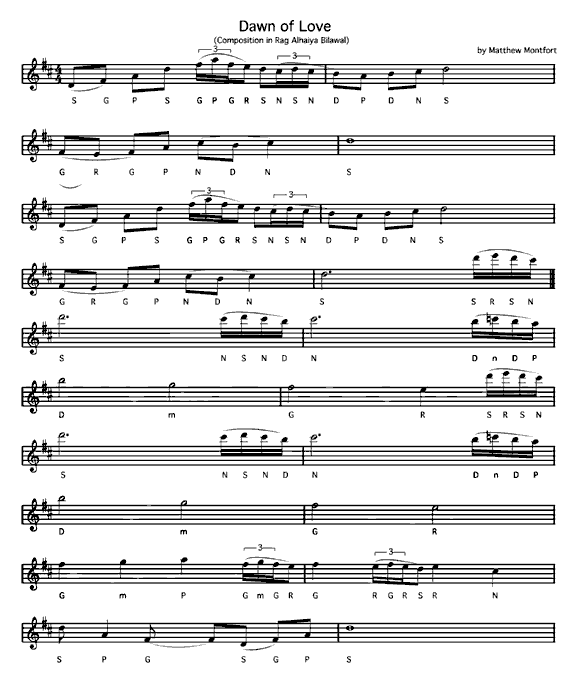Issue 10, Winter 2007: North Indian Raga Applied to Contemporary Music
Welcome to the World Rhythms News, an infrequent newsletter dedicated to world music education. This issue is dedicated to Hindustani raga, which is the melodic basis for the classical music of northern India, Pakistan, Nepal, and Bangladesh. To subscribe, use the form below. Follow instructions thereafter, and make sure to check "World Music Education" in the "Interests" section of the sign up process.
In this issue:
North Indian Raga
A raga is a melodic recipe for a mood. In Hindustani music, each raga has certain moods associated with it, and usually has a specific time of day and/or season in which it is meant to be played. Raga could be described as a “super scale” using a set of notes in ascending (arohi) and descending (avarohi) order, sometimes including prescribed alternate or zig zag routes (vakra chal), a hierarchy of note importance including king notes (vadi) and prime minister notes (samvadi) a fourth or fifth apart, and a key phrase that shows the heart of the movement of the raga (pakar).
This ancient system is both an art and a science of how musical notes create certain moods. Western music also recognizes that note order and hierarchy create a mood, with some theory texts noting that songs in major keys tend to communicate happiness while songs in minor keys show a feeling of sadness. But the rags show precisely how to create a specific mood. The recipe for each raga holds the key to an unlimited number of potential melodies, each perpetuating the mood contained in the raga, but each a unique work of art.
Study of this system can be of great benefit to any composer or improvising musician.
Sargam
Indian raga uses a system of solfeggio called sargam. There are seven note names per octave, just as in the Western “do re mi fa so la ti do” system, starting with “sa,” the tonic note that is also the main drone note. Indian music does not utilize the concept of “perfect pitch” where absolute note values are recognized. Sa can be set to any note, and is normally set to the most convenient place for the instrumentalist or vocalist. For example, a sitar is normally tuned with sa at a Western equivalent near C# or D because that is the most practical place for that instrument. The other notes are then found in relationship to sa.
Sargam: Sa Re Ga Ma Pa Dha Ni Sa Scale degree: 1 2 3 4 5 6 7 8 If sa is D: D E F# G A B C# D
Just as in Western music, there are 12 main tones per octave, but there are also microtonal ornaments similar to the use of quarter tones in the blues. Indian raga uses a non-tempered tuning system where Sa and Pa are tuned a perfect just fifth apart. The other notes are close to the Western just tuning system, but the tuning of individual notes can vary from raga to raga.
The note name system is much less confusing than the interval system in use in Western music. Each scale degree needs only one name because ragas do not change key. The word komal is used for the minor or flat version of a note, shuddh means natural or major, and tivra corresponds to sharp or augmented. Sa (1) and pa (5) cannot be modified. Re (2), ga (3) dha (6) and ni (7) can be either shuddh (normal or natural, corresponding to the Western major intervals) or komal (flat, corresponding to the Western minor intervals). Ma (4) can only be shuddh (the natural perfect 4th) or tivra (sharp, corresponding to the Western augmented fourth).
The main 12 tones are notated in sargam as follows:
S r R g G m M
sa komal re shuddh re komal ga shuddh ga shuddh ma tivra ma
perfect 1 minor 2 major 2 minor 3 major 3 perfect 4 augmented 4
.
P d D n N S
pa komal dha shuddh dha komal ni shuddh ni sa
perfect 5 minor 6 major 6 minor 7 major 7 perfect 8Raga Example
As an introduction to the raga concept for Western improvisors, we will examine Rag Alhaiya Bilawal, the raga that Ancient Future leader Matthew Montfort's popular composition "Dawn of Love" is based on.
Rag Alhaiya Bilawal
Time: late morning (9 am-noon)
Moods: sringar (joy and love), karuna (pathos, compassion, sadness)
Vadi (king note): Dha (major 6)
Samvadi (prime minister note): Ga (major 3)
Vadi-Samvadi (king and prime minister notes, listen via MIDI):
Pakar (heart phrase, listen via MIDI):
Arohi-Avarohi (ascending and descending, listen via MIDI):
Alhaiya Bilawal is the most commonly known raga of the Bilawal group of ragas, which are based on the same intervals found in the major scale. Bilawal is portrayed in ragamala paintings as a lady waiting in anticipation for her lover to arrive.
Ma, the perfect fourth, is normally omitted in ascent except for when it is used in an oblique manner. Komal ni, the minor seventh, is only used in descent in an oblique manner, as shown in the avarohi for the raga, where it appears sandwiched between two major sixths (dha).
Asthai and Antara
Written late one morning after practicing Alhaiya Bilawal as taught by Ali Akbar Khan, the following melody illustrates the concepts of asthai and antara. The asthai is the primary theme, similar to the refrain in Western music, and is usually performed in the middle register.The antara is the second, higher part of a composition, showing the upper register. This composition stays fairly close to the raga (even using the heart phrase intact), but yet exploits the natural tendencies of the guitar as well. It is an example of how ragas contain compositions just waiting to be discovered.
Dawn of Love (composition showing asthai and antara, listen via MIDI):
Guitar-Sitar Jugalbandi Performance of Dawn of Love
 "Jugalbandi" is a classical North Indian musical duet (literally "tied together"), in this case with the unusual configuration of sitar and guitar accompanied by tabla. This performance of "Dawn of Love" was rendered by the Guitar-Sitar Jugalbandi variation of Ancient Future featuring Pandit Habib Khan on sitar, Matthew Montfort on scalloped fretboard guitar, and Arshad Syed on tabla. It is an example of how the melodic elements of raga can be used in contemporary concert situations where it may not be feasible to explore one raga for an hour or so. The performance does not employ the full traditional unfolding form of Hindustani classical music: alap (the first section in which the notes of the raga are introduced and explored without rhythmic accompaniment), jor (second section included in or succeeding the alap, in rhythm, but without fixed meter), and jhala (the last section played with rapid strokes in a fast rhythm before the tabla enters), followed by a slow gat (fixed instrumental composition following the alap, jor and jhala, that signals the tabla player to join the performance), a fast gat and jhala (this time with tabla accompaniment). Instead here there is simply an introduction without tabla accompaniment (a loosely defined alap) by each melodic instrument followed by the main melody (gat) and solos with tabla accompaniment. The compositional form used here as closely resembles that of a jazz standard as it does that of Hindustani classical music. Interestingly, in this performance Montfort stays within the notes of the raga in his solo improvisations, while Pandit Habib Khan was moved to briefly explore a blues scale during his solo (from 6:02 to 6:33).
"Jugalbandi" is a classical North Indian musical duet (literally "tied together"), in this case with the unusual configuration of sitar and guitar accompanied by tabla. This performance of "Dawn of Love" was rendered by the Guitar-Sitar Jugalbandi variation of Ancient Future featuring Pandit Habib Khan on sitar, Matthew Montfort on scalloped fretboard guitar, and Arshad Syed on tabla. It is an example of how the melodic elements of raga can be used in contemporary concert situations where it may not be feasible to explore one raga for an hour or so. The performance does not employ the full traditional unfolding form of Hindustani classical music: alap (the first section in which the notes of the raga are introduced and explored without rhythmic accompaniment), jor (second section included in or succeeding the alap, in rhythm, but without fixed meter), and jhala (the last section played with rapid strokes in a fast rhythm before the tabla enters), followed by a slow gat (fixed instrumental composition following the alap, jor and jhala, that signals the tabla player to join the performance), a fast gat and jhala (this time with tabla accompaniment). Instead here there is simply an introduction without tabla accompaniment (a loosely defined alap) by each melodic instrument followed by the main melody (gat) and solos with tabla accompaniment. The compositional form used here as closely resembles that of a jazz standard as it does that of Hindustani classical music. Interestingly, in this performance Montfort stays within the notes of the raga in his solo improvisations, while Pandit Habib Khan was moved to briefly explore a blues scale during his solo (from 6:02 to 6:33).
Ancient Future Guitar-Sitar Jugalbandi in Concert at Larkspur Cafe Theatre March 31, 2007
Saturday, March 31, 2007, 8:00 pm (doors open at 7:30)
Guitar-Sitar Jugalbandi
featuring Matthew Montfort (scalloped fretboard guitar, Glissentar), Pandit Habib Khan (sitar), Arshad Syed (tabla, santur)
Larkspur Cafe Theatre
500 Magnolia Ave., Larkspur, CA, 94939
Adm: $22 adv. Tix: Larkspur Cafe Theatre Box Office, online at larkspurcafetheatre.com or charge by phone at 415-924-6107.
Print poster.
Additional music featuring Pandit Habib Khan and Matthew Montfort
The linked audio below is the song "Socha Socha," which is this ensemble configuration's contribution to the Planet Passion CD.
![]() Socha Socha by Ancient Future. Composed by Khan/Montfort.
Socha Socha by Ancient Future. Composed by Khan/Montfort.
Purchase Planet Passion CD (Ancient-Future.Com AF 2001): $17.98 Add 1 to Cart. Buy 1 Now. 
Further Study
For further study of raga, a good next step is "The Raga Guide: A Survey of 74 Hindustani Ragas" on Nimbus Records, which is basically a raga fake book complete with CDs featuring performance examples. Studying with a master Hindustani musician is also highly recommended.
For an explanation of tala, the recurring time-measure or rhythmic cycle employed in Hindustani music, see World Rhythms Issue 8: North Indian Tala. Play close attention to the 8 beat folk tala, keharwa, that the "Dawn of Love" melody is set in.
A good resource for learning North and South Indian rhythm is the book “Ancient Traditions--Future Possibilities: Rhythmic Training Through the Traditions of Africa, Bali, and India.” The above rhythms are from the audio guide tracks to this "world beat bible" by Matthew Montfort, leader of the popular world fusion music ensemble, Ancient Future. The book takes the student on a musical voyage through the traditions of Africa, Bali, and India with a series of exercises that require no instruments to perform. A must-have for all students of world music:
Ancient Traditions -- Future Possibilities: Rhythmic Training Through the Traditions of Africa, Bali and India. By Matthew Montfort. Kentfield: Ancient Future Music, 1985. ISBN 0-937879-00-2. Comb Bound Book, $33.95 (SALE! Normally $46.95): Add 1 to Cart. Buy 1 Now. Book/Enhanced 2 Audio CD Set with MIDI Soundfiles:$53.95 (SALE! Normally $74.95): Add 1 to Cart. Buy 1 Now.
The rhythms are now also available in audio format:
Ancient Rhythms--Future Grooves: MIDI Percussion Groove Tracks from the Traditions of Africa, Bali, and India PLUS Complete 2 CD Set of Audio Guide Tracks . By Matthew Montfort. Ancient Future Music (2005). Companion 2 Volume Enhanced Audio CD set with MIDI Soundfiles, 28.95 (SALE! Normally $39.95): Add 1 to Cart. Buy 1 Now. A complete 2 CD set of audio guide tracks PLUS a CD-ROM presentation of MIDI files based on the book Ancient Traditions--Future Possibilities.
This two CD/CD-ROM set of audio tracks and MIDI files helps reinforce the material in the book and insures practicing correctly and in rhythm. Volume I and covers the exercises in the West Africa and Bali chapters of the book. Volume II covers the exercises in the India and Future Possibilities chapters. The General MIDI sound files of the exercises in the book can be used with a web browser for playback, or can be loaded into a MIDI sequencer for greater control. The CD-ROM even includes MIDI maps of West African, Balinese, and Indian percussion sound assignments enable custom re-mapping to your patches and instructions to turn your sequencer into a tabla machine using VSTi plug-ins and included tabla samples.
All compositions, recordings, video, and text in this article © 2007 Ancient Future Music. All rights reserved.





